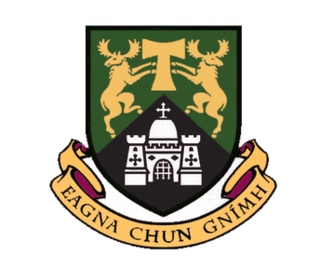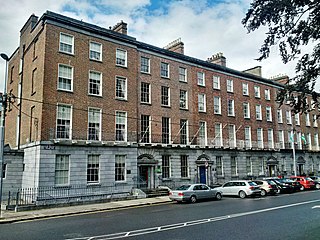
Limerick is a western city in Ireland situated within County Limerick. It is in the province of Munster and is located in the Mid-West which comprises part of the Southern Region. With a population of 94,192 at the 2016 census, Limerick is the third-most populous urban area in the state, and the fourth-most populous city on the island of Ireland at the 2011 census. The city lies on the River Shannon, with the historic core of the city located on King's Island, which is bounded by the Shannon and Abbey Rivers. Limerick is also located at the head of the Shannon Estuary, where the river widens before it flows into the Atlantic Ocean. Limerick City and County Council is the local authority for the city.

County Limerick is a western county in Ireland. It is in the province of Munster and is located in the Mid-West which comprises part of the Southern Region. It is named after the city of Limerick. Limerick City and County Council is the local council for the county. The county's population at the 2016 census was 194,899 of whom 94,192 lived in Limerick City, the county capital.

The University of Limerick (UL) is a public research university institution in Limerick, Ireland. Founded in 1972 as the National Institute for Higher Education, Limerick, it became a university in 1989 in accordance with the University of Limerick Act 1989. It was the first university established since Irish independence in 1922, followed by the establishment of Dublin City University later the same day.

The Hunt Museum is a museum in the city of Limerick, Ireland. The Hunt Museum holds a personal collection donated by the Hunt family, it was originally situated in the University of Limerick, before being moved to its present location in Limerick's Georgian custom house in 1997. The Custom House is situated on Rutland Street on the banks of the River Shannon at its confluence with the Abbey River. Among the museum's collection are works by notable artists and designers such as Pablo Picasso, Jack B. Yeats, and Sybil Connolly as well as distinctive historical items such as the O'Dea Mitre and Crozier.

As with other cities in Ireland, Limerick has a history of great architecture. A 1574 document prepared for the Spanish ambassador attests to its wealth and fine architecture:

Thomond Park is a stadium in Limerick in the Irish province of Munster. The stadium is owned by the Irish Rugby Football Union and has Munster Rugby, Shannon RFC and UL Bohemian RFC as tenants. Limerick FC played home games in Thomond Park from 2013 to 2015 in the League of Ireland while the Markets Field was being redeveloped. The capacity of the stadium is 25,600 following its large-scale redevelopment in 2008.

O'Connell Street is the main thoroughfare of the city of Limerick. It was previously known as George's Street until it was renamed after Daniel O'Connell. The street runs in parallel to the River Shannon and forms part of an overall thoroughfare, along with Rutland Street and Patrick Street, that bisects Limerick City Centre in a north east to south west direction. The street is about a mile in length, starting at the Arthurs Quay / Denmark Street junction and ending at The Crescent. A monument to Daniel O'Connell stands at the centre of The Crescent overlooking O'Connell Street. The street is noted for its Georgian architectural heritage.

Francis McCourt was an Irish-American teacher and writer. He won a Pulitzer Prize for his book Angela's Ashes, a tragicomic memoir of the misery and squalor of his childhood.

The People's Park is a park located by Pery Square in Limerick, Ireland, just west of the railway station and bus terminal. At the northern edge of the park is the Limerick City Gallery of Art.

The Ashbourne Cup is an Irish camogie tournament played each year to determine the national champion university or third level college. The Ashbourne Cup is the highest division in inter-collegiate camogie. The competition features many of the current stars of the game and is sometimes known as the 'Olympics of Camogie' because of the disproportionate number of All Star and All-Ireland elite level players who participate each year Since 1972 it has been administered by the Higher Education committee of the Camogie Association.

Limerick Museum, previously known as the Jim Kemmy Municipal Museum, is a city museum in Limerick, Ireland.

Newtown Pery is an area of central Limerick, Ireland, and forms the main city centre of the city. The district is known for its Georgian architectural heritage and is the core area of Limerick's Georgian Quarter. It is one of the three towns that make up modern-day Limerick City Centre, the other two being the older Englishtown and Irishtown, which date from the medieval period. Newtown Pery houses the largest collection of Georgian townhouses in Ireland outside of Dublin. In 1837, Samuel Lewis in his Topographical Dictionary of Ireland described Newtown Pery as "one of the handsomest towns in Ireland".

Pery Square is a Georgian Terrace located in the Newtown Pery area of Limerick city, Ireland. The terrace was constructed as a speculative development by the Pery Square Tontine Company between 1835 and 1838. The square was named in honour of the politician Edmund Sexton Perry. The terrace is notable as one of the finest examples of late Georgian architecture in Limerick and Ireland.

Irishtown is an area of central Limerick, Ireland. The area along with Englishtown and Newtown Pery forms Limerick City Centre. Broad Street, John Street and Mungret Street are the main streets in the district. St. John's Square, a prized early Georgian development is located here as is St. John's Cathedral and the Milk Market which is located off Mungret Street.
Davis Ducart, was an architect and engineer in Ireland in the 1760s and 1770s. He designed several large buildings and engineering projects. He had associations with the canal builders of the time and the mining industry and worked on many projects in the County Tyrone coalfield.
Naomi Carroll is an Irish Olympian and Ireland women's field hockey international. In 2015–16 Carroll won a Women's Irish Hockey League title with Hermes. Carroll has also played both camogie and ladies' Gaelic football at senior inter-county level for Clare and represented the Republic of Ireland women's national under-17 football team.
Lucy Hartstonge was an Irish heiress and philanthropist who founded the first fever hospital in Ireland, in the late 18th century.
The Bolton Library is a collection of books housed at the University of Limerick and a physical library building in Cashel, County Tipperary, Ireland. It is described as the largest and most important collection of antiquarian books in Ireland outside of Dublin.
The Limerick Civic Trust is an environmental, architectural conservation and educational organisation founded in 1982 that works to identify, record, preserve and publicise Limerick's culture, history, environment and architectural heritage. Although the trust works in conjunction with local authorities, state agencies and various commercial and professional entities, it remains an independent organisation and is entirely self-funded.
















